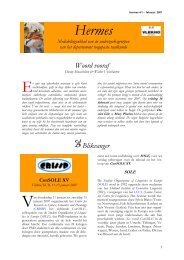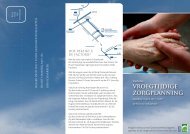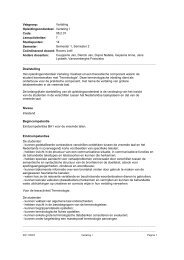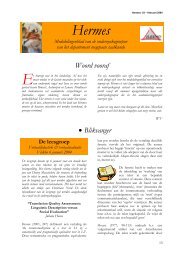HUB RESEARCH PAPER - Hogeschool-Universiteit Brussel
HUB RESEARCH PAPER - Hogeschool-Universiteit Brussel
HUB RESEARCH PAPER - Hogeschool-Universiteit Brussel
Create successful ePaper yourself
Turn your PDF publications into a flip-book with our unique Google optimized e-Paper software.
Process consultation revisited 5<br />
Worley, 2005), or as a family of OD interventions (French & Bell, 1998), alongside many others,<br />
that is especially suitable when dealing with socio-emotional processes and problems in work<br />
groups and organizations (e.g., dysfunctional conflict, deficient group processes, poor<br />
communication, ineffective behaviours and norms, etc.). Defined this way, process consultation<br />
has become just one of the intervention techniques or instruments in the OD consultant’s tool<br />
bag instead of a general philosophy or action principle that underlies each intervention effort<br />
during change processes.<br />
Process consultation has always been and still is an ambiguous concept and practice.<br />
Schein himself stresses this point in the preface of the revisited edition of process consultation<br />
(Schein, 1999a) contemplating that colleague advisors and managers still don’t understand the<br />
essence of ‘process consultation’: it is not a technique or a collection of interventions for<br />
working with groups, it is not a model for non-directive counselling, and it is not an occupation<br />
or full-time job. Process consultation is essentially about building a helping (client-consultant)<br />
relationship through a continuous effort of “jointly deciphering what is going on” (Schein,<br />
1999a, p. 6) in the ongoing interaction, relationship and situation in order to make co-authored<br />
choices about how to go on. In the concluding chapter of Process Consultation Revisited Schein<br />
(1999) states that:<br />
The decisive factor as to whether or not help will occur in human situations involving<br />
personality, group dynamics, and culture is the relationship [italics added] between the<br />
helper and the person, group, or organization that needs help. From that point of view,<br />
every action I take, from the beginning contact with a client, should be an intervention<br />
that simultaneously allows both the client and me to diagnose what is going on and that<br />
builds a relationship between us. When all is said and done, I measure my success in







